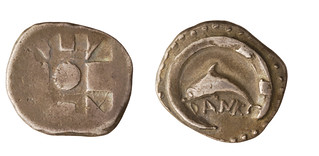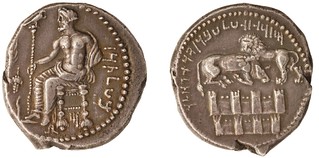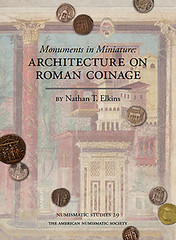
PREV ARTICLE
NEXT ARTICLE
FULL ISSUE
PREV FULL ISSUE
BOOK REVIEW: MONUMENTS IN MINIATURE
In a November 19, 2015 post on the American Numismatic Society's Pocket Change blog. Matthew Wittmann provides some
information on the new book on architecture on Roman coinage by Nathan Elkins. -Editor
Although the emphasis is on Roman coinage, earlier Greek types are also featured for comparative analysis, including this sixth century BC silver stater of Zancle that shows harbor buildings on a sandbar encircling a dolphin. 
In the Persian empire, city walls were a traditional symbol of power that were often represented on the coinage produced by the satrapies of Cilicia and Phoenicia. A particularly fine example of this tradition is this mid-fourth century BC tetradrachm of Tarsus, which depicts a lion attacking a bull above two rows of turreted walls. 
The volume features over two hundred images and provides a comprehensive catalogue of Roman architectural coin types organized into Early, Late, and Provincial sections. I don’t want to step on Elkins’ detailed analyses here, but I do want to highlight one of the more spectacular coins, a cistophorus of Augustus from the mint at Pergamon that depicts the Temple of Mars Ultor on the Capitoline Hill in Rome. 
As Elkins indicates, this particular representation likely bore no resemblance to the actual structure, which some historians argue was never actually built. Still, it is a lovely example of numismatic art!
Here are a few selected paragraphs excerpted from the book's Introduction. -Editor
The regular representation of the built environment on coins was a purely Roman phenomenon among the ancients. In the Greek world, architectural representation on coinage was very uncommon; when it did appear it referred directly to the local identity of the issuing state. Coins of the Persian satrapies only rarely depicted fortifications in conjunction with traditional Persian emblems of royalty, power, and shrines of the chief deities in the minting city. The Roman use of the iconography of building was fundamentally different. From the first occurrence in 135 BC through the late Roman Empire, the architectural images on coins from Rome commemorated or politicized the monument in question. By the mid-first century BC and into the Imperial period, architecture had become commonplace in the repertoire of Roman coin iconography. The representation of monuments is one of the most beloved (and belabored) topics in studies of Roman coin iconography. It is also a theme in dire need of re-exploration. Why was Rome the only ancient civilization to depict man-made monuments habitually on its coinage? Why did Greek urban centers with marble-clad monuments and politically charged building programs feature their great monuments on coins only after Roman domination? What social and cultural developments prompted Roman moneyers in the late second and first centuries BC to depict buildings on coins for the first time? What circumstances led to a lower frequency of architectural coin types in the third and fourth centuries AD until they ultimately disappeared from the Roman coinage in the fifth century? And why were these late Roman depictions more symbolic in their lack of reference to specific constructions? These are questions to be explored. This book departs from the treatment of the images as sources for the appearance of ancient monuments. Instead it explores the historical, artistic, social, and cultural contexts of the iconography of building on Roman coins from its emergence in the late second century BC to its disappearance in the fifth century AD. For more information, or to purchase, see:
To read the earlier E-Sylum article, see:
Wayne Homren, Editor The Numismatic Bibliomania Society is a non-profit organization promoting numismatic literature. See our web site at coinbooks.org. To submit items for publication in The E-Sylum, write to the Editor at this address: whomren@gmail.com To subscribe go to: https://my.binhost.com/lists/listinfo/esylum All Rights Reserved. NBS Home Page Contact the NBS webmaster 
|
